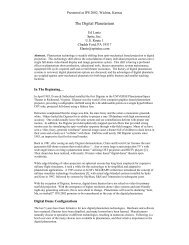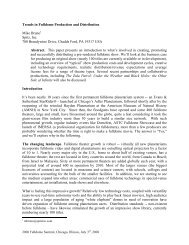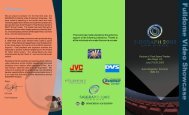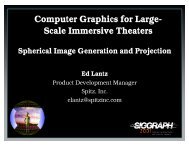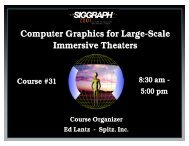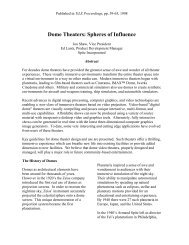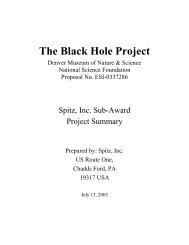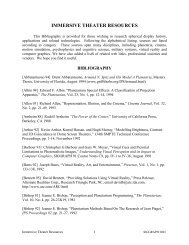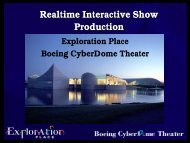Fulldome Producers
Fulldome Producers
Fulldome Producers
Create successful ePaper yourself
Turn your PDF publications into a flip-book with our unique Google optimized e-Paper software.
<strong>Fulldome</strong> Production using 3DAnimation Tools at Home RunPicturesBACKGROUND: Home Run Pictures hasbeen involved in creating content for over10 years to varied clients worldwide. Thecompany's past successes have come in partfrom the attitude of always looking for thenext challenge with passion. Although wehave not been a large studio in size, thatattitude has put us many times at theforefront of new trends and newtechnologies.Our past experience has garneredinvolvement with a wide variety of mediaoutlets... from animated films and televisionprogramming to scientific visualization andinteractive applications. We have createdanimation for Discovery Channel, NationalGeographic, PBS, General Motors, andNASA.CHALLENGE: Five years ago we wereapproached by a company that wasdeveloping projection tools to completely filla traditional planetarium dome with aseamless video image... they had theprojection system, but no content. Thechallenge was just what we were looking forand we slowly begin solving the technicaland creative problems we faced with the newformat. Our 3D animation toolset seemedwell suited to address the problems we werefacing.DESIGN: The creative challenges of creatingfor the format are many... traditional filmmakingrules do not always apply. Toeffectively tell a story in a way thataudiences have learned from experience withmotion pictures and television, it isnecessary to address the audience'sframeless “free” viewing of the scene andcome up with ways to direct their view tocommunicate important storyline events.And the dome must not be treated like acircle shaped viewport or the potential of the360x180 degree immersive environment islost... and the dramatic view becomestiresome.PRODUCTION: There also was the need todevelop new proprietary software tools todeal with creating in the fulldome format...off the shelf tools, even those used to createtoday's motion picture special effects are notdesigned to deal with the immersive viewscreated by the overlapping projection setup.Color and contrast control in a sphericalenvironment where the image reflects ontoitself had to be overcome. And previewingscenes intended for display on a full domeon two dimensional computer screensestablished the need to rethink theanimation approval processes.Following are several case histories ofprojects we have worked on recently withsample imagery and short descriptions ofthe creative and technical challenges eachentailed.Currently, we are one of few animationproducers creating for these new fulldomevideo projection formats. Most systemsuses multiple HD video projectors to createa seamless image over the entire surface of atraditional planetarium dome. Other systemsincorporate a single fish-eye style projectorto achieve the same imagery experience at alower resolution. The result is an immersiveexperience that is captivating, practicallytransporting the audience into the scenewith the ability to look all around at the360x180 degree view.
Home Run Pictures has an extensive webpage where sample imagery from past workis showcased on an ongoing basis. Checkout http://www.hrpictures.com to see avariety of case histories in all the areas ofanimation production including fulldomework.What's in the Siggraph demo....The demo is a collection of various all-domecontent we have produced over the pastseveral years. Some sequences are shown ascomplete scenes and clips from longer worksare shown to give you an idea of the overallcontent.<strong>Fulldome</strong> Demo Listing:+ Titanic+"Microcosm: The Adventure Within"+ Big Bang+ Wild Ride - Canyon/Thunderstorm+ Dinosaurs+ Cave Paintings/Mammoths
<strong>Fulldome</strong> Production of "Microcosm: The Adventure Within""Microcosm: The AdventureWithin" is an immersive presentationemploying a fulldome projection format...utilizing multiple video projectors tocompletely fill a planetarium style dome withimagery... resulting in the audience beingimmersed in our sci-fi styled story where aminiaturized sub, Alpha, is injected into apatient to seek out a stubborn infection andcombat the nasty virus. The format allowsthe audience to go with the sub's crew andits humorous artificial intelligent-ROV,Scout, into the human body like neverbefore... no longer looking at a traditionalscreen's "framed" view, but able to look left,right, up... all around as if they were actuallysitting in the environment created by thedome’s surface... imagine the excitement ofriding along on the trip... the imageryprojected on a 60+ foot 360x180 degreescreen complete with surround sound audioeffects.As previously mentioned in theintroduction, the creative challenges ofcreating for the format are many. Toeffectively tell a story in a way thataudiences have learned from experience withmotion pictures and television, it isnecessary to address the audience'sframeless “free” viewing of the scene andcome up with ways to direct their view tocommunicate important storyline events.Our storyline required that we present theprogram in an edited scene to scene, multicamera viewpoint. This would involve cutsand transitions, sometimes in quicksuccession, in the fulldome environmentThe "frameless" view presented a problemfor this style of storytelling... would theaudience be able to follow the story withoutvisual confusion.Relying on skills from traditional" framed"animation work, we were able to expand theprinciples to the fulldome environmentthrough tests and motion testing to achievea new set of film-making rules. Our storywould bring the audience into the humanbody in ways that the fulldome environmentwas best at. SInce you are continually insidesome variety of sphere or cylinder, theimmersive view was a perfect fit for thesubject. During the program, the audience
follows along as the little sub's crewexplores artories, the inner ear, the eye, theheart, the workings of a living cell, and evenan attack by virus invaders.New tools were developed to handle the full360x180 degree image creation... problemsinherent in the available softwareapplications were discovered early on.Creation of fulldome masters required thestitching together of multiple camerarendered views, an atypical requirement thatsoftware designers have ignored in theirattempt to create faster tools. What liesoutside the rendered frame is generallyconsidered superficial until you begin tobutt images up to one another and discoverthat sampling and clipping issues do notallow for a seamless match across thedome's surface. Color and contrast control ina spherical environment where the imagereflectes onto itself had to be overcome aswell. And the management of the massiveamounts of rendering and finishing required,while still maintaining creative quality,prompted the development of a specializedproduction pipeline.The end result is an immersive environmentthat is quite dramatic for the viewer. Startingwith the traditional planetarium domeconfiguration... video projectors arepositioned around the base of the dome...These hi-definition projectors arespecifically modified to project a properlyfocused and "vignetted" image on a sectionof the dome's interior surface... Byoverlapping the projected areas, theseamless image is created. These newprojection systems further open uppossibilities beyond the traditionalplanetarium realm and are just beginning tobe realized.Home Run Pictures president Tom Caseyproduced and directed for the productionalong with lead animators Desiree Roy andTom Nypaver handling the bulk of theanimation effort. Animator Gerry Wagnercontributed by creating various displaygraphics and models. Software tools usedvaried, but Alias/Wavefront Maya andPowerAnimator were the main animationapplications.A network of SGI unixworkstations, PC's and Macs wereemployed. Approximately eight months ofrendering on a 12 processor render farm wasneeded to finish the 15 minute program. Datastorage for the finished program andintermediate layered elements was neartwoTeraBytes and secured against failure bya RAID5 disk array.
Production of "The Night of the Titanic" in <strong>Fulldome</strong>"The Night of the Titanic" isan immersive presentation employing thefulldome projection format... utilizingmultiple video projectors to completely filla planetarium style dome with seamlessimagery... the audience is treated to a "youare there" style drama, just as if they wereone of the survivors in the Titanic's fewlifeboats... the immersive all-dome view nolonger limits the viewer to looking at atraditional screen's "framed" view, butenables you to look left, right, up... allaround at the imagery created by thedome's 360x180 degree surface.In one scene, the audience is transportedtwo miles down to the bottom of the oceanwhere the wreck of the Titanic now sits...the viewer is immersed in the cold,secluded underwater environment... onlythe handful of people who have gonedown in the few submersibles that candive this deep have had the experience ofseeing the Titanic were she now rests... ina fulldome theater, it's just like you arethere... as the popular story is retold, theaudience is given panoramic views of thelast two hours of the famous liner's life...just as if they were one of the fewsurvivors seeing it from one of thoselifeboats.One issue that needed to be solved wasthat the viewing frame of a typical domemakes it difficult to show a sceneinvolving a flat plane/landscape (or in thiscase waterscape). Some dome setups areactually tilted up to 30 degrees to avoidthis problem. In the end it was discoveredthat the audience is able to accept a tiltedimage orientation as long as it isconsistantly presented.Other scenes created in the fulldomeformat include a dramatic view of the
iceberg strike from below the water line asonly an immersive fulldome projectionsetup could reveal... the audience can beseen craining their heads as the shippasses overhead... a true indication of theeffect the environment has on the viewer.The underwater sequences were a perfectfit to the immersive feel in fulldomepresentation.The story is further told with standardvideo imagery vignetted into fulldomescenes... this "framed" imagery is actuallythe same animation sequences used byThe Discovery Channel in itsdocumentary series on the Titanic... madeavailable to the museum through a specialarrangement with Home Run Pictures whoworked with Discovery to produce thebroadcast series.All the Titanic imagery is presentlyavailable should a planetarium, sciencecenter or museum at some time in thefuture plan an educational program on theTitanic. The night scenes feature anaccurate starfield, so stories dealing withwhat survivors saw in the sky that nightcan coexist with a dome's sky projector.There are approximately 15 minutes ofTitanic imagery available, of which about 4minutes are in all-dome format. The alldomescenes are also available in standardformat should a planetarium presently nothave fulldome capability.Home Run Pictures created the immersivepresentation, "The Night of the Titanic" incooperation with the Houston Museum ofNatural Science's Burke Baker Planetarium.The program premiered at the planetariumon April 14, 2002, the 90th anniversary ofthe Titanic's sinking and has beenextremely successful and well reviewed.
"Big Bang" Sequence for <strong>Fulldome</strong> Planetarium Show Use...As part of their new Galileo's Legacy show,the Houston Museum of Natural Science'sBurke Baker Planetarium asked Home RunPictures to create a two minute sequence ofthe history of the universe from the BigBang to present time. Nobel laureate StevenWeinberg was the consulting expert for thescientific theory. The sequence is in the newfulldome format where multiple HD videoprojectors are used to completely fill thedome and give the audience the feel ofactually being in the scene.... able to lookright, left, forward, even behind for a trulyimmersive experience.Newly developed software tools werenecessary to deal with this subject-matter inthe large scale imagery of the fulldomeformat. Creative director Tom Caseyproduced and directed for the productionalong with lead animators Desiree Roy, TomNypaver and Gerry Wagner handling thebulk of the animation effort.The sequence premiered at the Houstonfacility in March 2003 and will be availableas a separate sequence to planetariums,science centers and museums worldwidewho have a fulldome projection capability.Select frames from the sequence are shownhere.We begin with our all-dome view in blackand suddenly the entire view explodes everywhere at once with hot energy... a smalldigital clock begins ticking off the time invery small fractions of a second...Still less than a second on our clock (ourtime is greatly expanded from reality), theenergy cools off to an overall blue... we seeelectrons and quarks zooming around us like
ees, some pass close by our view... as weapproach 1 second of time on our clock,cooling continues and some of the particlesbegin to collide and clump into protons andneutrons...As we approach 3 minutes of time on ourclock, the universe continues to cool... ourclock time unit begins to speed upexponentially into years of time and ataround 300,000 years, atoms of hydrogenand helium begin to form and clump intocloudy collapsing masses... proto-starsbegin to form and quickly explode as supernovas creating heavier atoms of matter...The clumping continues as proto-galaxiesbegin to form... our clock is now at 1 billionyears, time is passing ever faster... onegalaxy begins to form close in our frontview... other galaxies begin forming off in thedistance all around us... we are now close to10 billion years from the initial explosion...the close galaxy evolves into our Milky Wayand M31 can be seen as the other majorspiral in the Local Group... the other galaxiesall around us slowly expand/move awayfrom our point of view... our clock is now at15 billion years, the present day.
"Wild Ride" Canyon Sequence for HMNS Burke Baker PlanetariumThe final closing sequence in the HMNSBurke Baker Planetarium show "Earth's WildRide" is a fast roller coaster ride down acanyon during a torrential thunderstorm. Ifyou would like to experience the need tograb onto your chair during an immersivefulldome show, this one's for you. Themotion is designed to give the audience thethrill of flying down a canyon with a rapidlymoving river just inches below their view.Near misses of lightning, falling trees,landslides, diving through tunnels, full 360pitches and eventually a plummet over awaterfall all are part of this sequence.The three minute sequence took almosteight months of production time to createand the various scenes required hundreds oflayers to give it a natural look. Using acombination of 3D, mattepaintings andparticle effects, animator Tom Nypaver andpainter/modeler Gerry Wagner attempted togive the viewer a real wild ride... everythingexcept really getting wet.Opening with a dry desert scene, a lonehawk-like bird floats high above us. Wefollow the bird as our view rotates and wesee an anvil shaped thunderhead... lightningarching across the menacing dark cloud. Wemove towards the storm.Faster and faster, like like the first hill on aroller coaster, we descend into the cloud...water and hail strobbing in the electricallycharged environment. The camera rotatesdown and chases a single drop as it fallsrapidly toward Earth. The drop gets blownfrom side to side and the camera continuesto correct and center the drop as weplummet.
We can begin to make out ground detailsand we see the beginnings of a canyon cutby a mighty river flow. Our drop is headingtowards a lonely tree growing near thetopside of the canyon wall. The drop hits aleaf on the tree and our view follows the leafas it swoops and banks in the wind on a ridedown the river. We ride the leaf over therapids as the canyon walls rush past atalarming speed.A lightning strike fells an old tree above usand it comes crashing down nearly hittingus. We dive through a tunnel-like pass andare nearly buried by a mud slide... the windpicks up our leaf and we spin 360 degrees.The roar of the wind and the water growsand we are suddenly perched high above awaterfall and begin the stomach wrenchingdive down. The view fades to black as wereach the bottom.As the scene fades up again all is calm, thesun is shinning as we see a grasshoppercontentedly chewing our battered leaf. Wehear a screech from behind us then afluttering noise as a bird dives out ofnowhere, grabbing the grasshopper, leavingour leaf, and then slowly the bird glides upinto the now clearing sky.Several other scenes are now in productionfor this immersive fulldome show, includingsubjects ranging from dinosaurs andmammoths to volcanos and asteroid strikes.
Panorama Style Earth Theater Shows Life-sized Animated T-RexThe new overlapping multiple projectionsystems now available for presenting videoprograms allow for filling full or partial domescreens with imagery and immersing theaudience in the scene. Typically used in thelatest planetarium shows, The CarnegieMuseum of Natural History (Pittsburgh)decided to use the capability to create their"Earth Theater," 210 degree (partial dome)wrap-around experience, to supplement itsinternationally known dinosaur exhibit.Multiple camera views are rendered and then"stitched" into a single image that isseamlessly projected with vignetted-edgeprojectors, creating a panorama view.Surround sound audio completes theexperience... watch out for that T-rex to yourright!In order to accurately create what would endup being viewed as a life-sized version ofthe extinct animals... Home Run Pictures'animators created bio-mechanically correctcontrols to "keyframe" the motion of the T-Rex... based on current research studies.Over a gigabyte of hand painted imagerywas used to color and texture the animals inwhat scientists today believe may have beena possible "look" for our big friends. Duringthe motion test phase of the project,animators placed the T-Rex in present dayscenes to better comprehend the scale ofthese now extinct creatures.The sequences were used in the Carnegie'spremier Earth Theater show and, in audiencepolls, they were sited as the most popularscenes by 80% of attendees.
Future projects in the <strong>Fulldome</strong> Format..." Apollo 11." It's a wonderful story filled with all the wonder of whatcan be accomplished when you try. It's full of science, engineering, and thepassion of people. It has always been a perfect subject for a planetarium show...but... now with the ability to fill the entire dome with a seamless video image, itcan be told like never before.Imagine moving up through the Earth's atmosphere with the powerful Saturn 5rocket from a viewpoint just ahead of the Apollo capsule. Watching the Moongrow larger and then looking behind you to see the Earth getting smaller. Racingover the cratered surface of the Moon as the LEM departs to descend to thesurface. Seeing the LEM land as if you were an imaginary Moon inhabitantwatching from a few feet away and then standing on the surface with the first twohumans to walk on the Moon... all with an immersive view and the freedom tolook all around at your slightest whim." Dinosaurs." An ever popular subject in whatever visual media that isemployed. Just imagine what could be seen if you could go back in time andexperience these great animals. Using the "framelessness" of the fulldome formatcould be the next best thing to actually being there.Imagine standing just under the belly of a stalking Tyrannosaurus as he hidesjust out of sight of a heard of Hadrosaurs and then bursts out to attack. Orwalking with a herd of saurapods, their long necks towering high above yourview. Or moving rapidly through the low lying plant life with a small group ofVelociraptors chasing a Gallimimus. Or experiencing the hatching of a babyMaisaura in its nest.With the immersive feel of the fulldome view, this will be a remarkableexperience...
Home Run Pictures has an extensive web page where all-dome immersive projects that we produce are featured as each project is completed.Please feel free to check out new postings...http://www.hrpictures.comFor further information on these projects or all-dome immersive production in general, contact: Tom Casey:tom@hrpictures.comHome Run Pictures + 100 First Avenue, Suite 450 + Pittsburgh, PA 15222 + 412-391-8200© 2003 H o m e R u n P i c t u r e s
Democratizing a Dome: A Story ofEducation, Art, Entertainment, Research, and Economic Developmentin One <strong>Fulldome</strong> TheaterOverview:David Beining, DirectorLodeStar Astronomy Center, University of New MexicoSIGGRAPH 200328 July 2003The LodeStar Astronomy Center, a University of New Mexico project, is exploring and exploiting its fulldometheater from a wide variety of means and purposes. Unfettered by traditional notions of what aplanetarium/theater can be and do, LodeStar is the physical setting for a ‘metacenter’ dedicated to creating aculture of fulldome production and presentation for the benefit of New Mexico, with a secondary intent to helpmature and grow the use/culture of the fulldome medium and the related industries and venues.Partners in the dome-based ‘metacenter’ include: dozens of students and faculty, three colleges, fivedepartments, and four centers within the University of New Mexico; faculty from several other prestigiousuniversities; professional artists and media producers; novice animators from the community aged 13 to 60;economic development officers; fulldome technology vendors; and others.LodeStar’s ‘metacenter’ approaches the dome from many perspectives; each is intended to extend benefits tocreators, consumers, the LodeStar theater, and the fulldome medium:Educationally driven efforts include supporting LodeStar’s mission of informal science education and formalcourses and programs within the University of New Mexico. (www.lodestar.unm.edu) LodeStar staff aresupported by UNM instructors and community volunteers in creating fulldome animations for the daily‘planetarium’ shows. In turn, UNM faculty are supported by LodeStar staff in offering UNM students theopportunity to create fulldome material from computer science and media arts courses, as well as someindependent projects by advanced students. The vision: Creating a culture and community of fulldome producersworking independently or collaboratively to make immersive experiences “that set the mind soaring.” The byproduct:Experienced digital art students with a portfolio that can find jobs and joy in computer graphics-relatedindustries.UNM’s Arts Technology Center leads art initiatives through artist-in-residence programs which include facultyfrom prestigious universities and colleges, as well as other professional artists--all of whom are creating for thedome. (http://atc.unm.edu) The Center also supports the initiative through workshops, grant-writing, etcetera. In addition, College of Fine Art faculty are creating their own art while supporting their students’ work inthe dome. Finally, a cadre of accomplished artists locally and internationally are also helping define the dome asan art house from outside formal UNM ties, but with LodeStar support. The vision: Expanded outlets for artistsand art events/festivals for the public. The by-product: A new medium for expression.Every culture needs its entertainment and the fulldome culture is no different. In a fluid initiative based in theexperiments and products from the education and art initiatives comes the notion of entertainment shows basedin the fulldome medium. Currently, the LodeStar dome is home to frequent special events to presentcommunity-based productions. In July 2003, LodeStar hosts the world’s first fulldome animation festival inconjunction with the ultra-cool “Flicks on 66” digital filmfestival. (www.flickson66.com) The vision: To createentertainment shows for the ‘dominate’ culture whilesupporting those within the subculture. The by-product: Areplacement for the planetarium-based laser show, an outletfor digital artists to present themselves without programlimitations, and revenue to support the theater and theproducers.The potential of fulldome is nowhere near lost on scientists.Computer scientists and natural science research lust after thescale and immersive nature of the dome. The computer folksat UNM’s High Performance Computing Education & ResearchCenter are experimenting with cluster-based realtime systemsbased in their ironically titled “FlatLand” software.
(www.arc.unm.edu) Research scientists are providing data sets for depiction in the dome; their desire: toimmerse themselves and 140 of their colleagues in their data to expand their “discovery space.” Partners at theSanta Fe Institute’s Art and Science Laboratory are creating tools and programs to present the sights and soundsof chaos and complexity theory interactively in the immersive environment. (http://artscilab.org/body.html)The science vision: To create new, powerful, low-cost tools to present and interact with data to improve theirresearch and understanding. The by-product: Moving fulldome beyond astronomy in educational programs,improved modeling systems, and serving the science community in the quest for new knowledge.Finally, the mighty dollar and opportunities of the metacenter’s participants to stay and work at home. Whileeconomically arid, New Mexico has unparalleled wealth when it comes to its history and community of art andscience. Certainly, the fulldome medium offers great opportunity to serve as a nexus for artists and scientists tocollaborate and network. The LodeStar theater is serving as something of a town-hall for economic developmentin the digital arts by hosting networking and planning meetings for such similarly-minded efforts like the DigitalFilm-Making Institute (www.digitalfilmmakinginstitute.org) Beyond this modest role is the ‘Digital PuebloProject,’ an amazing NSF-funded program working to build an infrastructure for digital art training and productionin the Land of Enchantment. (http://atc.unm.edu/digitalpueblo.html) The project is building ‘technologypods’ around the state to train community members in the digital arts through a mentorship program. Thesexiest part is that the participants learn while working on real productions—movies, advertising, and, of course,the LodeStar Theater. Currently, the program has folks aged 13 to 60 at the keyboards. In the LodeStar-basedstudio, they’re creating fulldome animations about Mars for a show opening in early 2004. They’ve also createdfulldome work in collaboration with an Athens Greece theater—giving these nascent artists an international reachin their very first production. Look for an application sketch on the Digital Pueblo Project somewhere inSIGGRAPH 2003.About the <strong>Fulldome</strong> Presentation:Run Time = 14 minutesThe LodeStar portion of the theater presentation will include sights and sounds created through theaforementioned programs of fulldome experimentation and exploitation. The following is partial list of supportersand creators who have championed the effort:Laurel Ladwig, Hue Walker, Ed Angel, Sheryl Hurley, Ben Shedd, Christopher Jordan, Aarron Romero, DanaeFalliers, Michael Stearns, Jason Zermeno, Brad Carvey, Ernie Herrera, Sally Bowler-Hill, Bryan Konefsky, MarcosBaca, Richard Rand, Chris Chafe, Steve Savage, Gregg Stephens, Mary Tsongias, Tony Della Flora, GregNiemeyer, Marty Martinez, Patrick Vanderpool, Gail Wight, Gronk, Michael Trujillo, Jim Crutchfield, Mark Nava,Scott Niskach, Tom Caudell, Dupuy Bateman, Scott Mathias, Chris Davis, David Dunn, Ginger Savage, Joe Dean,Andrea Carvey, Keith Baca, Rudy Martinez, Jack White, Jennie Zieher, Alex Kolberg, Bryce Hemple, Grub, RyanWyatt, Cat Vanderpool, Dan McGraw, Sam Stanley, Lorenzo Wang, John Gallegos, Thomas Michael Teegan, TyRyder, Al Lucero, Rudy Martinez, J.D. Bridges, and dozens of unnamed community members and UNMstudents/faculty who have, or are waiting to create for or support the dome.The demo will include:1. Sequences created through UNM courses and personal effortsfrom students such as:• Aaron Romero• Marcos Baca (“Jellies,” right)• Marty Martinez• Mark Nava• Keith Baca (“Jellies,” right)• Rudy Martinez2. Faculty leadership and instruction provided by:• Ed Angel, Computer Science & Arts Technology Center (below)• Bryan Konefsky, Media Arts• Mary Tsongias, Media Arts• Danae Falliers, Arts Technology CenterEd Angel, Ph. D. [left] is professor of computer science, directorof the Arts Technology Center, the Open GL guru, and one hell ofa LodeStar supporter and fulldome innovator. He’s also a leaderof New Mexico’s initiative for economic development in film andthe digital arts. Oh, along with Ernie Herrera, he’s also theprincipal of the Digital Pueblo Project. What’d you do today?…
Left: A domemaster from Hue’s art for the dome. Herdemo will be accompanied by a Michael Stearns score.Below: A domemaster from a 8-minute sequencecreated by UNM animation instructors Sheryl Hurley,Chris Jordan, and Hue Walker. They created the 2/3Danimation entirely on their own time and initiative.Their reward? Many thanks and some pizza and beerfrom the under-funded L*.5. Work for-and-by LodeStar’s mission and shows by Planetarium Manager Laurel Ladwig.Theater manager Laurel Ladwig [left, with Yoshi & Sirius] is toLodeStar what light is to astronomy; in a word, everything. Thetalented and indefatigable one supports every effort through expertadvisement, post processing work, theater control and a whole lot ofgood natured fun and patience. She’s a dedicated educator,naturalist and conservationist, but with a gluttonous need for digitaltools.Laurel also happens to make fulldome animationsand graphics that set minds soaring with thewonder and beauty of the night sky. You’ll see herwork in the demo as we introduce the program andshow you Jupiter in an unforgettable way [right].Laurel and Hue have a irrefutable mantra:“A woman’s place is in the dome.”Who’s arguing?
6. Digital Pueblo Project: First work of the community-training program for fulldome productionFunded by the National Science Foundation, the Digital Pueblo Project is an economic development initiativeprovide digital arts training to community members from all walks of life. Through a mentorship program,participants learn by working on real-world projects, including television and big screen movies and, of course,the giant screens of fulldome theaters. The LodeStar demo will include the first voyage into fulldome productionby the first group of Digital Pueblo participants.Left & Below: Domemaster from the first works byDigital Pueblo Participants. The Puebloans havecreated four Olympic-themed animations is aproject with the Eugenides Foundation’s developingfulldome theater in Athens, Greece. The work willbe presented as part of the new theater’s opening.Above: The fulldome participants and mentors (leftto right):• Thomas Michael Keegan• Ty Ryder• Dan McGraw• Alex Kolberg• Cat Vanderpool• Sam Stanley• Chris Davis, instructor• Aaron Romero, instructor• Bryce HempleThe Digital Pueblo Project is led by:• Ed Angel (Page 2)• Ernie Herrera• Hue Walker (Page 3)• Sally Bowler-Hill
About the Presenter:David Beining – LodeStar Director: David Beining is a writer/sociologist working in an astronomy center withartists and computer nerds, which may explain some of LodeStar’s unorthodox ways andvisions. As director of the LodeStar Astronomy Center, a University of New Mexicoproject located at (and in partnership with) the New Mexico Museum of Natural History,Beining clumsily navigates within multiple bureaucracies, cultures and agendas. He isthe founding director of LodeStar, which opened with one of the world’s first fulldometheater in 2000. Forever indebted to his UW-Madison upbringing, Beining has beenbuilding informal educational institutions and creating educational programs for morethan 10 years.His scholarly pursuit is understanding the social implications of--and opportunities for--new communication technologies. His Master’s Degree research took him to the formerSoviet Union to investigate how the nascent Internet service “GlasNet’ was used to disseminate information aboutand mobilize resistance to the 1990 coup attempt. (Those lessons are not lost in the LodeStar dome.) Hisprogrammatic passions are improving the production and educational values of museum-based media and inexperimenting with the integration of art and science.His heroes include: Laurel Ladwig, Ben Shedd, Hue Walker, Steve Savage, Janine Boire and Michael Stearns,from whom he grows and plagiarizes routinely. He claims to live in a submarine in Albuquerque with his wifeTracy and sons Gabriel and Aidan, to whom he just might read too many children’s books.Find him at dbeining@nmmnh.state.nm.usFind LodeStar at www.lodestar.unm.edu- qed -



